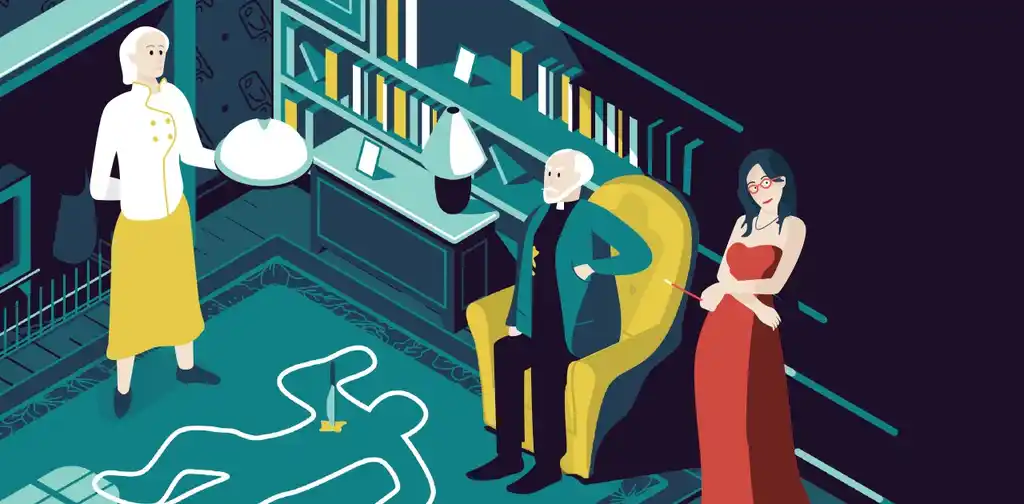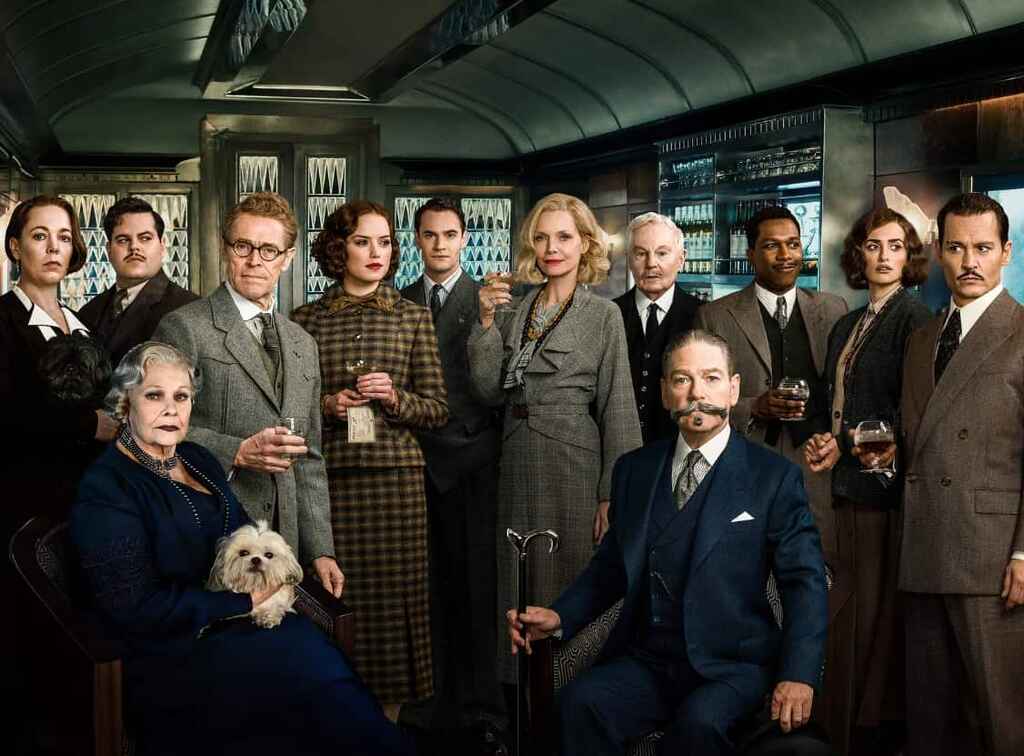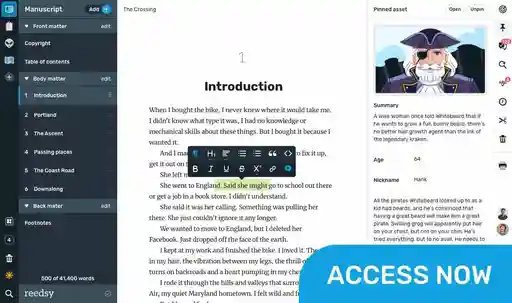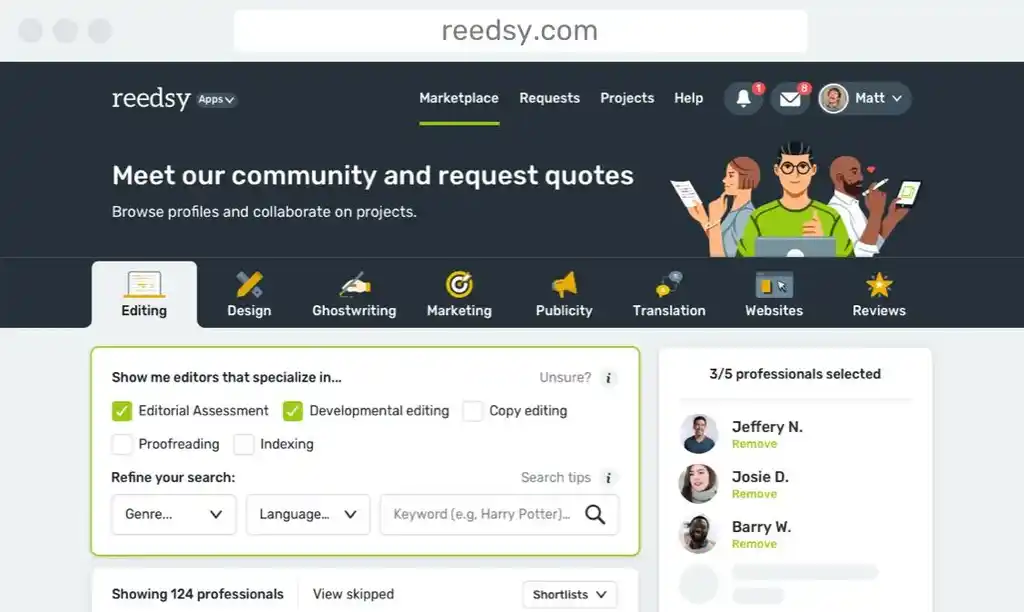Guides • Perfecting your Craft
Last updated on Oct 28, 2024
Point of View: The Ultimate Guide to Writing POV (+ Examples)
About the author
Reedsy's editorial team is a diverse group of industry experts devoted to helping authors write and publish beautiful books.
More about the Reedsy Editorial Team →Martin Cavannagh
Head of Content at Reedsy, Martin has spent over eight years helping writers turn their ambitions into reality. As a voice in the indie publishing space, he has written for a number of outlets and spoken at conferences, including the 2024 Writers Summit at the London Book Fair.
View profile →Just as every story has a beginning and an ending, it also has a point of view (POV) that guides readers through it all. The POV of any piece of writing will determine the lens through which it is told, which will in turn impact the way that your audience will interact with the text.
This guide will look at each type of point of view in literature, and provide examples that will help you understand them better. Let’s dive in.
🖊️
Which POV is right for your book?
Take our quiz to find out! Takes only 1 minute.
What is point of view?
Point of view is the narrative perspective from which a story is told. In fiction, there are three main types of point of view (POV): first person, second person, and third person, which also includes third person limited and third person omniscient.
Meanwhile, a new point of view, fourth person, has started to emerge in creative writing. An author can also mix and match all of these POVs to tell a story from multiple points of view.
To identify which type of POV you’re reading, start by asking yourself: who is telling me the story right now? Who is the narrator?
And if you’re confused, worry not! We’ll take you through them all in this guide, and show you how to differentiate them.
Choosing a point of view
As a writer, you’ll be asking yourself different questions about point of view. Indeed, choosing a point of view in writing is one of the most important decisions you’ll make because it will shape your entire story. It will dictate:
- How much narrative distance you put between your narrator and the reader,
- How readers engage with your text, and
- How much control you have yourself over your voice and exposition.
Therefore, if you’re an author, the key questions you’ll want to ask when it comes to choosing a viewpoint will be: How best can this story be told? What are the demands of your particular story? And what do you feel comfortable writing?
Your decision will determine who is telling the story — and how the information is being filtered to the audience.
6 point of views every writer should know
Now that we’ve established the importance of point of view in writing, let’s look at each POV in-depth — as well as the advantages and disadvantages of each.
- First Person
- Second Person
- Third Person Omniscient
- Third Person Limited
- Fourth Person
- Multiple Points of Views
First person
First person narratives are quite common and relatively intuitive to write: it’s how we tell stories in everyday life. The narrator tells the story from their own perspective using pronouns such as I, me, my, we, and our. For example:
I told my mother that we had lost our passports.
First person can create intimacy between the reader and the characters, granting us direct access to their emotions, psyches and inner thoughts. In stories where the protagonist’s internal life is at the fore, you will often find a first-person narrator.
Having a single fixed narrator can limit the scope of a story 一 the reader can only know what the narrator knows. It’s also said that a first person narrator is biased, since they provide a subjective view of the world around them, rather than an objective one. Of course, this isn’t necessarily a bad thing, and intentionally unreliable narrators are fascinating literary creatures in their own right.
Genres that commonly use a first person POV
Young Adult. Introspective coming-of-age narratives often benefit from a first-person narrative that captures the protagonist’s voice and (often mortifying) internal anxieties. Some examples are novels like The Hunger Games by Suzanne Collins, The Fault in Our Stars by John Green, and The Catcher in the Rye by J.D. Salinger.
Science Fiction. In sci-fi novels, a first person perspective can nicely convey the tension and awe associated with exploring unfamiliar environments and technologies. Some examples of this approach include Project Hail Mary by Andy Weir, Flowers for Algernon by Daniel Keyes, and Ready Player One by Ernest Cline.

Memoir. The first person is perfect for memoirs, which allow readers to relive life events with the author. Some pageturners in this genre are Open by Andre Agassi, Educated by Tara Westover, and Becoming by Michelle Obama.
Examples of first person POV in literature
In the following examples, you’ll be able to see the first person point of view in action. Note the way that the character speaks directly to the reader. By virtue of being inside of the narrator’s head, the reader is able to establish a rapport with them quickly (which authors can also take advantage of, by introducing an unreliable narrator).
When you tap into a character’s mind, it’s also the character’s style of talking and thinking that you’ll experience. What’s the range of their vocabulary? What do they ponder the most? First person lets you nail down a truly individualistic voice.
Hunger Games by Suzanne Collins
It’s this detail, the untucked blouse forming a ducktail, that brings me back to myself.
“Prim!” The strangled cry comes out of my throat, and my muscles begin to move again. “Prim!"
I don’t need to shove through the crowd. The other kids make way immediately allowing me a straight path to the stage. I reach her just as she is about to mount the steps. With one sweep of my arm, I push her behind me.
“I volunteer!” I gasp. “I volunteer as tribute!”
The Curious Incident of the Dog in the Night-Time by Mark Haddon
This is a murder mystery novel.
Siobhan said that I should write something I would want to read myself. Mostly I read books about science and maths. I do not like proper novels. In proper novels people say things like, 'I am veined with iron, with silver and with streaks of common mud. I cannot contract into the firm fist which those clench who do not depend on stimulus.’ What does this mean? I do not know. Nor does Father. Nor do Siobhan or Mr Jeavons. I have asked them.
Remains of the Day by Kazuo Ishiguro
It seems increasingly likely that I really will undertake the expedition that has been preoccupying my imagination now for some days. An expedition, I should say, which I will undertake alone, in the comfort of Mr Farraday’s Ford; an expedition which, as I foresee it, will take me through much of the finest countryside of England to the West Country, and may keep me away from Darlington Hall for as much as five or six days. The idea of such a journey came about, I should point out, from a most kind suggestion put to me by Mr Farraday himself one afternoon almost a fortnight ago, when I had been dusting the portraits in the library.
To learn more about this point of view, read our full guide on First Person Point of View here.

FREE COURSE
Understanding Point of View
Learn to master different POVs and choose the best for your story.
As you might expect, after first person comes…
Second person
Second person narratives are far less common in literature — but not entirely unheard of. The narrator addresses the reader directly using you, your, and yours, as in:
You instruct the chief of police to bring the prisoner to your office.
Second person POV is all about putting the reader directly in the headspace of a particular character: either the protagonist or a secondary figure. When mishandled, this POV can alienate readers — but when executed well, it can create an intimate reading experience like no other.
Since this POV requires quite a lot of focus for most readers, it’s often suited to shorter stories, or lyrical pieces of writing, like poetry. It can also be used alongside other points of view to provide variety in a longer novel, or to indicate a change of character (see: The Fifth Season by N.K. Jemisin).
Genres that commonly use a second person POV
Creative Fiction. Short stories, poetry, and screenplays can benefit from the immediacy and intimacy of the second person. Two examples are The Brief Wondrous Life of Oscar Wao by Junot Diaz, or Pants are Optional by Aeris Walker 一 a brilliant piece from Reedsy’s Short Story competition.
Nonfiction. In self-help in particular, the second person can be used to ‘enter the reader's mind’, establish rapport, and guide them through a transformation process. For example, in Eckhart Tolle's The Power of Now many teachings are conveyed through a series of questions and answers written in second person.
Now that you have seen how second person narratives work, let’s meet some third person limited narrators and see how they handle things.
Examples of second person POV in literature
In the following examples of second person POV, you’ll see the way that it forces readers to become an active participant in the story, as they’re told what they ought to be feeling, thinking, smelling, touching, and seeing. Rob Spillman, the editor of Tin House, once said: "I have a pet peeve against the second person that I call the second–person accusatory: 'You are walking down the street.' I go, 'No, I am not walking down the street!'"
But it can become something else entirely in a skilled writer’s hands. Author Jay McInerney, one of its most famous practitioners, once described the second-person as an unspoken invitation: “Come on in.”
Bright Lights, Big City by Jay McInerney
You have friends who actually care about you and speak the language of the inner self. You have avoided them of late. Your soul is as disheveled as your apartment, and until you can clean it up a little you don’t want to invite anyone inside.
If On A Winter’s Night A Traveller by Italo Calvino
You are about to begin reading Italo Calvino’s new novel, If on a winter’s night a traveler. Relax. Concentrate. Dispel every other thought. Let the world around you fade.
Fifth Season by N.K. Jemisin
You are she. She is you. You are Essun. Remember? The woman whose son is dead.
Check out our guide on Second Person Point of View for even more examples of this point of view.
Now that you have seen how second person narratives work, let’s meet some third person limited narrators and see how they handle things.
Third person limited
Now we come to the third person point of view, which arguably is one of the most popular POVs alongside first person. The narrator tells the story about other characters using he, she, they, his, hers, and theirs:
She told him that their assessment of the situation was incorrect.
As we mentioned earlier, third person is usually split into two categories: third person limited and third person omniscient. Third person limited is where the narrator only knows the thoughts, feelings, and understanding of a single character at any given time — hence, the reader is “limited” to that perspective. Between chapters, many books switch from character to character, but you will only hear one perspective at a time. For instance:
She couldn't tell if the witness was lying.

The limited third person POV portrays characters from a bit of distance, and asks the readers to engage and choose who they’re rooting for 一 but this POV poses a challenge for authors when trying to create truly compelling characters. A limited perspective definitely adds intrigue, but writers should bear in mind that being able to tell only one side of the story at a time can limit their ability to reveal important details.
Genres that commonly use a third person limited POV
Romance. A love story always has two sides, and the third person point of view is ideal for authors who wish to convey both. Examples in this genre include Shadow and Bone by Leigh Bardugo and The Grand Sophy by Georgette Heyer.
Thriller. In suspense-driven plots the limited third person POV works well, since it’s fun to try and solve a mystery (or mysterious characters) alongside the protagonists. Two examples are Murder on the Orient Express by Agatha Christie, or Nine Perfect Strangers by Moriarty Liane.
Examples of third person limited POV in literature
In the following examples of the third person limited POV, you’ll see how you can control “camera angles” through it. For instance: do you want the narration hover next to your character’s brain? Or do you want to back away and let a certain section of the story unfold from a wider-angle perspective?
Unlike the first person point of view, third person limited isn’t obligated to remain inside the character’s head. There’s room to adjust, depending on what the story demands at a given moment.
The Lie Tree by Frances Hardinge
In Faith’s mind, it was always that. She never gave it another name, for fear of yielding it yet more power over her. That was an addiction, she knew that much. That was something she was always giving up, except that she never did. That was the very opposite of Faith as the world knew her. Faith the good girl, the rock. Reliable, dull, trustworthy Faith.
1984 by George Orwell
In its second minute the Hate rose to a frenzy. People were leaping up and down in their places and shouting at the tops of their voices in an effort to drown the maddening bleating voice that came from the screen. The little sandy-haired woman had turned bright pink, and her mouth was opening and shutting like that of a landed fish. Even O’Brien’s heavy face was flushed. He was sitting very straight in his chair, his powerful chest swelling and quivering as though he were standing up to the assault of a wave.
Alanna: the First Adventure by Tamora Pierce
Suddenly Alanna frowned. A picture was forming in the fire. That was impossible— she wasn’t supposed to See anything. Maude was the one who had cast the spell. Maude was the only one who should See anything.
Ignoring all the laws of magic Alanna had been taught, the picture grew and spread. It was a city made all of black, shiny stone. Alanna leaned forward, squinting to see it better. She had never seen anything like this city. The sun beat down on gleaming walls and towers. Alanna was afraid—more afraid than she had ever been. . . .
Maude let go of the twins. The picture vanished. Alanna was cold now, and very confused. What had that city been? Where was it?
If you’re interested in trying out this POV in your own book, read our guide on Third Person Limited here.
If you’re done with the intimacy of “close” viewpoints, perhaps we can interest you in a different POV — a God’s-eye view of storytelling.
Third Person Omniscient
The third person omniscient is as popular as the limited one, and uses the same pronouns. The difference, however, is that the narrator is “all knowing” — meaning the narrator knows the thoughts and feelings of all the characters at once and can can reveal anything that is happening, has happened, or will happen in the world of the story. For example:
He thought the witness was honest, but she didn't think the same of him.
It’s a popular point of view because it allows a writer to pan out beyond the perspective of a single character, so that new information (beyond the protagonist’s comprehension) can be introduced. At the same time, it heavily relies on the voice and authority of the narrator, and can therefore take some focus away from the character.
Genres that commonly use a third person omniscient POV
Fantasy fiction. In elaborate fantasy worlds, being unencumbered from a character’s personal narrative means that the narrator can provide commentary on the world, or move between characters and locations with the flick of a pen. You’ll see this approach in action in Reaper Man by Terry Pratchett, Howl's Moving Castle by Diana Wynne Jones, and The Chronicles of Narnia by C. S. Lewis.
Literary fiction. An all-encompassing perspective can allow authors to explore different character quirks, but also interpersonal dynamics between characters. Leo Tolstoy does this masterfully in his great classics Anna Karenina and War and Peace.
Examples of third person omniscient POV in literature
In the following examples, you’ll see the power of the third person omniscient POV in its ability to slip into the minds of several characters — at any given moment. This not only gives the author plenty of room to experiment with the pacing of the story, but also presents a unique opportunity to delve into the psychology of multiple characters.
Pride and Prejudice by Jane Austen
Elizabeth, having rather expected to affront him, was amazed at his gallantry; but there was a mixture of sweetness and archness in her manner which made it difficult for her to affront anybody; and Darcy had never been so bewitched by any woman as he was by her. He really believed, that were it not for the inferiority of her connections, he should be in some danger.
Brokeback Mountain by Annie Proulx
During the day Ennis looked across a great gulf and sometimes saw Jack, a small dot moving across a high meadow, as an insect moves across a tablecloth; Jack, in his dark camp, saw Ennis as night fire, a red spark on the huge black mass of mountain.
Hard Times by Charles Dickens
In truth, Mrs. Gradgrind’s stock of facts in general was woefully defective; but Mr. Gradgrind in raising her to her high matrimonial position, had been influenced by two reasons. Firstly, she was most satisfactory as a question of figures; and, secondly, she had ‘no nonsense’ about her. By nonsense he meant fancy; and truly it is probable she was as free from any alloy of that nature, as any human being not arrived at the perfection of an absolute idiot, ever was.
The simple circumstance of being left alone with her husband and Mr. Bounderby, was sufficient to stun this admirable lady again without collision between herself and any other fact. So, she once more died away, and nobody minded her.
To learn more, check out our full guide on the Third Person Omniscient POV here.
But let’s not forget the rarer POVs that also exist in literature…
Fourth person
Though still uncommon, fourth person POV is a new narrative style that uses a first person plural voice (“we,” “us,” “our,” and “ours”) to represent multiple characters speaking as a single narrator. Like so:
It is known where we come from, but no one much cares about things like that anymore. We think, Why bother?
The above example is from Chang-rae Lee’s speculative fiction novel, On Such a Full Sea. Notice that it’s a group of characters speaking. That’s what differentiates it from 1st person plural POV. To learn more, we recommend reading our full guide on fourth person POV.
Multiple Point of Views
Writing from multiple points of view is also a type of POV that’s gaining traction in some circles. (Game of Thrones, anyone?) Though often seen in epic fantasies with sprawling casts, you’ll also see it in literary fiction. William Faulkner’s As I Lay Dying is a notable example of the latter.
However, it’s a difficult technique to master, in no small part due to the challenge of tackling each character’s unique voice. For tips on writing it, refer to our guide on how to write multiple points of view.
Now that we have established the basics of the major points of view, let’s dig a little deeper. Head over to the next post in this guide to learn more about first person perspective.



5 responses
Aysha says:
19/04/2020 – 19:56
The Book Thief would be considered First Person POV, similar to Arthur Conan Doyle's Sherlock Holmes, right? Thank you for the wonderful information. It gave a lot of insight into choosing which POV would be most suitable for a particular story. Pretty clear-cut.
Sasha Anderson says:
31/05/2020 – 10:41
I sometimes have difficulty telling the difference between third person limited and omniscient. For example, in the quote from I am Legend, the sentence "If he had been more analytical, he might have calculated the approximate time of their arrival" sounds very omniscient to me, because Robert wasn't, and didn't. Is there an easy way to tell that this is limited rather than omniscient, or does it not really matter as long as it reads well?
Lilian says:
18/06/2020 – 05:15
This was a very helpful piece and I hope it's okay to share the link for reference.
↪️ Martin Cavannagh replied:
18/06/2020 – 08:51
Of course! Share away :)
Lilian says:
18/06/2020 – 05:44
It deal with the challenges associated with POV in writing. I like that it clearly distinguishes between third person limited POV and third person omniscient POV as most beginner writers are guilty of abrupt and inconsistent interchange in the two leading to head hopping. Greattach piece, I muse confess.